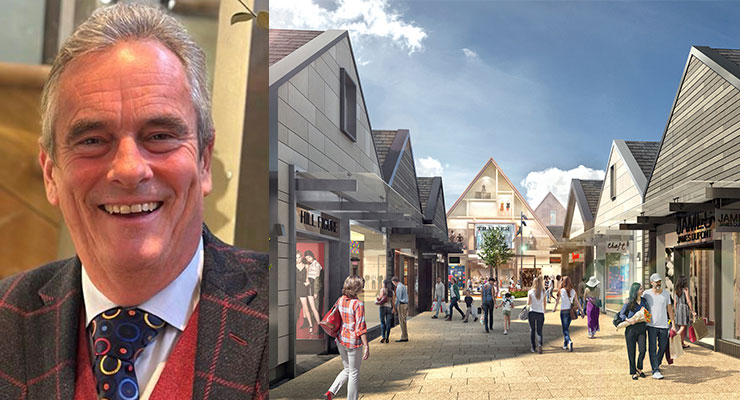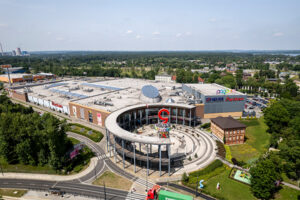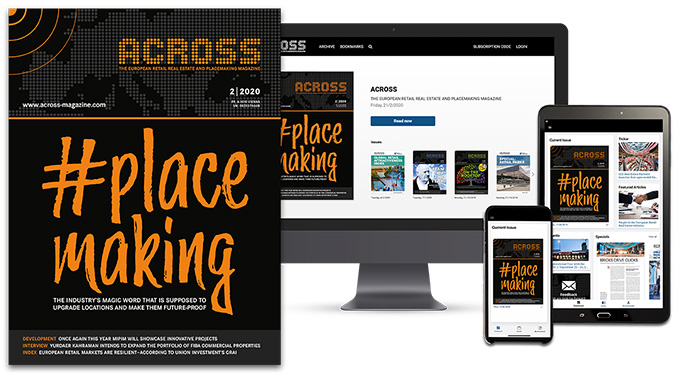By Giles Membrey
Having spent many of these articles discussing our development at Malmö Designer Village – which we now have with FREY – I am excited to talk about our next project at Grantham in the UK. From my point of view, Grantham commands one of the best locations in the UK. It has 750 meters of frontage to the A1, the fourth-busiest freeway in the country, and approximately 28 million vehicles pass the site on the A1, the A603, or the A52 every year.
The catchment area will take in Cambridge and Peterborough to the south, Lincoln and Doncaster to the north, Nottingham to the north-west and Leicester to the south-west. As with most outlets, it’s about location, location, location, and with the frontage to A1 and a new dedicated four-way junction, I can’t think of many better – it’s a fantastic location compared to other schemes. There’s also a real lack of full price retail in the immediate vicinity, especially the 30-minute catchment, which means that many people in the area, which is relatively affluent, may well use the outlet as their primary shopping source.
In many ways, Grantham Designer Outlet Village will follow the very successful blueprint we created for Malmö Designer Village regarding sustainability, brands, and overall customer experience. It will, for example, be one of the greenest outlet centers in the UK. We’re looking at BREEAM excellent and other major sustainable initiatives. With up to 250 EV charging points by the end of Phase Two, it will be one of the largest charging hubs in the UK. This will allow for further signage on the road networks, drawing consumers travelling in various directions.
Sustainability is central to the development, helping to create a space that complements the environment and enhances the well-being of staff and visitors. The scheme’s design also aims to bring regeneration, investment, and greater visibility to the region while providing an effective platform for tenant brands to maximize their ESG policies, such as ethical sourcing and sensitive resourcing.
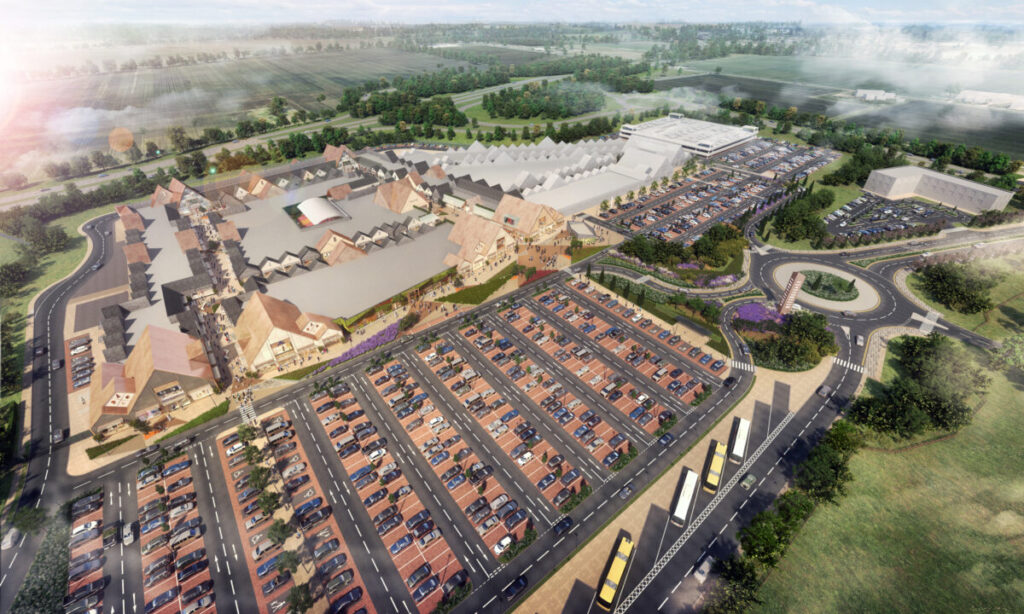
The sensitive combination of materials will form a structure that is in keeping with the surroundings. As part of this, the British Research Establishment’s Green Guide to Specification has been used to choose materials with a low environmental impact (rated A or A+ where feasible). There is also a focus on materials with low embodied energy. The units are designed to be well insulated and electrically heated using green energy suppliers. The scheme will also ensure the most effective use of the developed footprint with all material from the earthworks used on the site. Furthermore, it has been designed to allow tenants to collaborate with the operator to minimize waste from day-to-day trading.
The energy strategy encompasses various passive and active measures including building fabric U-values that are above the standards defined in Part L of the Building Regulations; high efficiency mechanical ventilation with heat recovery; energy-efficient heating, ventilation and air conditioning systems; energy efficient light fittings and controls; high performance solar controlled glazing; internal layouts and facades that are designed to promote suitable daylight provision, and PV panels on the roof of the buildings, hidden from public view. Rainwater will be recycled, whilst beehives on the roof and a wormery in the service yard will further enhance the sustainable nature of the scheme. We will use locally sourced timber and steel materials for the scheme. We are also considering using locally sourced landscaping and more local companies to help us deliver the project. As a result of this future first approach, the development will improve carbon emissions beyond Building Regulations Part L at approximately 10.9% and the scheme has already achieved a BREEAM ‘Very Good’ Certificate.
CLOSE BY LEISURE ACTIVITIES
There will also be a hotel on the site. We know that there are many leisure opportunities in the area such as Burleigh House, Belvoir Castle, Sir Isaac Newton’s house, the National Trust estate at Belton House and the RAF museum at Cranwell, so the hotel will allow visitors to the outlet to stay over and visit these attractions should they so wish. And being in an area with a rich farming tradition, we will also have a farm shop on site. Again, this is not something I am aware of being included in any other outlet. We’re also providing a unit for local businesses, which they can take for a month, six months, or maybe even a year to create a kind of pop-up. This will allow local businesses to benefit from the 2.5 million visitors we expect to attract to the outlet.
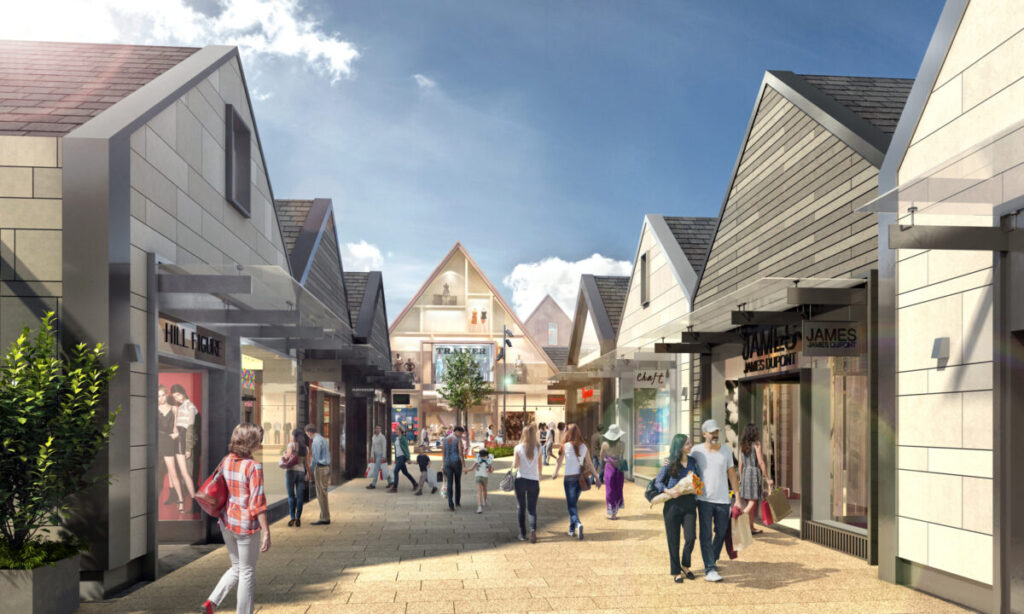
Grantham Designer Outlet Village will take 20 months to build and four months to fit out. ///credit: Rioja Estate
F&B will be another big part of the development. Several restaurants have already legally committed to the scheme, offering cuisines such as Italian and Asian. We won’t have any fast food outlets – these are restaurants only – but we will provide coffee shops throughout the scheme where customers can wind down, re-charge, and then continue shopping.
It’s almost certainly because of this modern, holistic approach to the development that we generate such a significant amount of interest from investors and brands. We’ve already had contact with several overseas investors looking to get a foothold in the UK outlet market. Off the back of that, we’re talking to funds that have never invested in outlets before but are interested in working alongside an existing investor. Interest from premium brands is also high with around 45% of the units either pre-leased, in heads of terms or legals, including premium brands in men’s fashion, ladies’ fashion, and sportswear.
The most significant financial challenge in bringing a project like this to fruition is getting funding to start on site. The building contract will be somewhere in the region of 72 million Euros. Having enough legally binding brand support to give a fund the confidence to put up that sort of money is a challenge, but that’s true for any developer active in the outlet sector. That, and the fact that the scheme will take 20 months to build and four months to fit out, so you’re asking a brand to commit to a unit in a new market, in a new development, which is more than two years away, and that is always very tricky.
We also need to be mindful of the impact of online retail, but rather than competing with online, we are embracing it by working with companies like Wishibam, as we did at Malmö. Wishibam is an online platform that enables the brands to generate additional income through selling goods from their outlet online. We’ve been working with them for the last three years and they also have partnerships with outlets at Villefontaine in Lille and the Marques Avenue portfolio. They have proved that they can add significant value in rental income.
The outlet will have a massive impact on Grantham as a location. We expect to attract 3 to 3.25 million visitors when the scheme matures. And those visitors can use the town center and enjoy linked visits to the attractions I mentioned earlier. Once we have completed phase two of the outlet, we expect somewhere between 1200–1500 jobs to have been created. We’re looking to get funding by the end of April 2025. At this point, we will review the sustainability initiatives and the BREEAM excellent rating we want, and look at the tender packages we prepared a couple of years ago. Once we have refined the building contract, we will appoint a building contractor for the scheme to start on site by Autumn this year.
The significant challenges in getting to this stage have revolved around Covid and Brexit, which have put off a couple of the international brands because of tax implications and logistics. The war in Ukraine has pushed construction prices up, adding to the existing inflationary pressure on construction costs, which have spiralled. We are now reviewing this and looking at value engineering opportunities to arrive at a more sensible price for building the scheme.
LONG TERM IMPACT
In terms of the long-term impact of Grantham Designer Outlet Village, much like the scheme we developed at Cannock, I expect it to become a dominant center for the Midlands and quickly be one of the top 10 outlet centers in the UK.
Ultimately, we want to create something different. We want someone who’s driven for 45 minutes from Peterborough to go: “Wow, I’ve got nothing like this in Peterborough!” Why bother if you’re putting in the same brands as Peterborough town center? You need something different. We would also like to look at one or two local brands in terms of food and beverage and retailers, who perhaps aren’t as big. As a fund, you’ve got to take a bit of a risk. You don’t always get the covenant, you might need to look at some brands that bring some differential. They may only have two stores, but you as a fund must accept that. So instead of having a 59 million Euro covenant, they only have a 590,000 Euro covenant because they are a small brand.
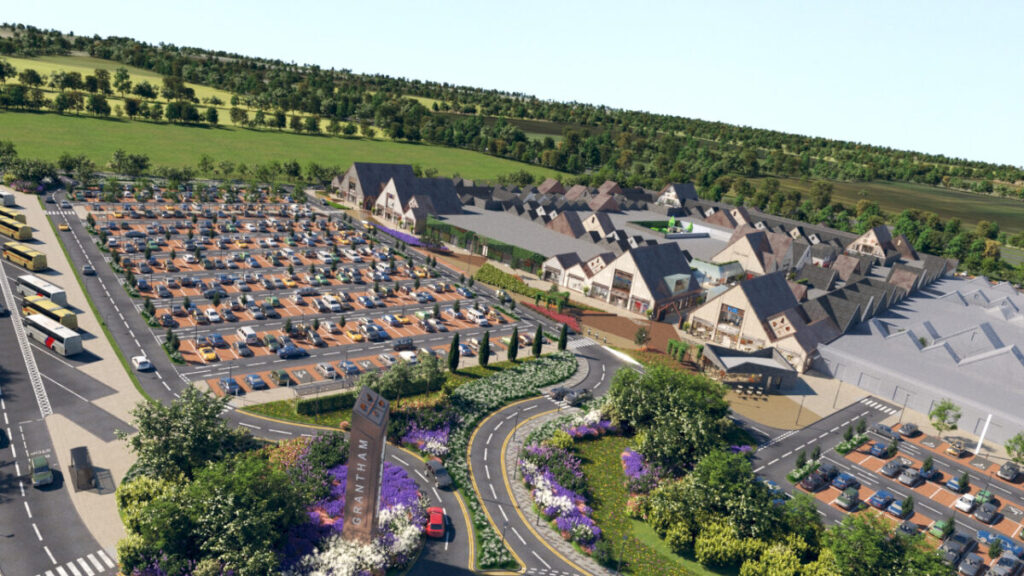
Regarding the outlet market in general, as it becomes more saturated, particularly in places like the UK, when you’re designing and developing an outlet, you’ve got to make sure that it’s best in class. To stand out these days, you must do things differently, meaning everything about a development must be best in class. The demands on operators have grown too. They want to ensure they’re maximizing the trading performance of the scheme by adding significant rental income for the landlord through better management. I would say commercialization has become more critical with the addition of pop-up restaurants and pop-up stores. Technology is also vital from an advertising and promotional perspective. For example, it is crucial to have a website for the scheme that guests can visit before getting in their car.
As we approach saturation point in Europe, several existing outlet centers will be refurbished and repositioned, and investors will work harder to generate as much income as possible from them. Given that the outlet model is based on turnover rent, it’s all about marketing and creating footfall and then converting that footfall into Euros and cents to increase the rental income.
Expect to see more VIP areas, personal shoppers, and areas where people can down tools, recharge and store their bags so they don’t have to carry them around the whole center. Play areas for kids are a must, and some leisure is also helpful. At Grantham, we haven’t ruled out buying additional land for complementary services. Brand portfolios have changed a little bit. Sport is still the biggest one – always has been and always will be. Some major sports brands like Adidas, Nike, Puma, Under Armour, New Balance, and ASICS like outlets, and they also trade very well there. Ladies’ fashion has always been quite weak, so we need more ladies’ fashion brands coming in.

Giles Membrey
Giles Membrey is the Managing Director of Rioja Estates Ltd
